Melqart › Early Dynastic Period In Egypt » Ancient origins
Articles and Definitions › Contents
- Melqart › Who Was
- Early Dynastic Period In Egypt › Antique Origins
Ancient civilizations › Historical and archaeological sites
Melqart › Who Was
Definition and Origins
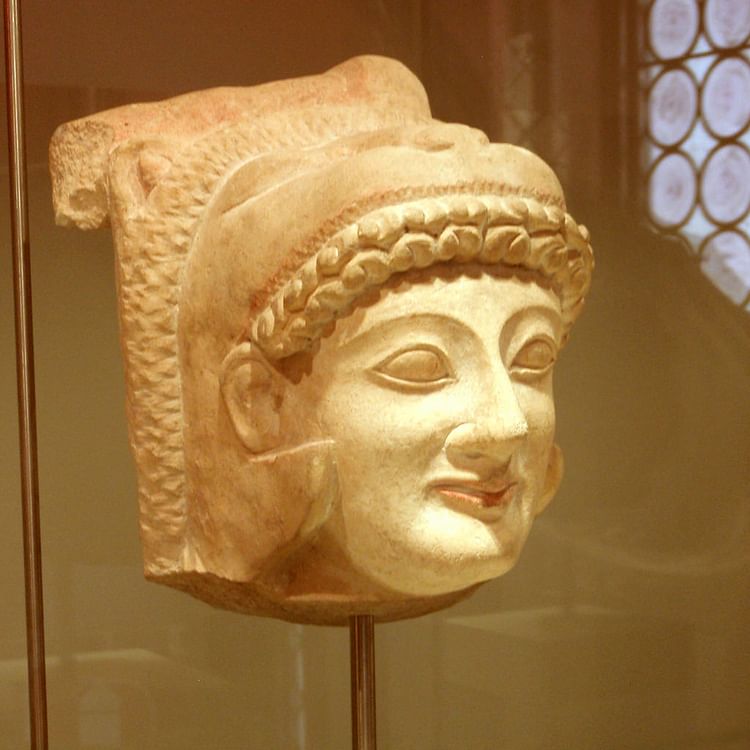
Melqart (also Melkarth or Melicarthus) was an important Phoenician god and patron deity of the city of Tyre. Associated with the monarchy, sea, colonization, and commercial enterprise, both at home and abroad the god is a significant, if still somewhat mysterious, figure of the Phoenician religion. As with other Phoenician gods and their culture in general, first-hand information from the Phoenicians themselves is scarce and details of worship and mythology are sorely lacking. Historians have been obliged to piece together scraps of information from contemporary cultures and what can be discovered from Phoenicia ’s colonies. Nevertheless, Melqart's stature is attested by the reverence the god was accorded by two of the Phoenician's immediate successor cultures in the ancient Mediterranean: Greece and Carthage.
MELQART'S ASSOCIATIONS
While Baal, El, and Baalat were important deities at other Phoenician cities, Melqart was considered the head of the pantheon at Tyre. Indeed, his very name means 'king of the city' ( melekqart ) and he was referred to as Baal de Sor or 'Lord of Tyre'. Melqart, in addition, assumed some of the characteristics of both Adonis and Eshmun as he was the focus of a festival of resurrection each year in the month of Peritia (February-March) in which a sacrifice was made by fire or a figure of the god was ritually burnt. Hence, his other name the 'fire of heaven'.
Melqart was considered by the Phoenicians to represent the monarchy, perhaps the king even represented the god, or vice-versa, so that the two became one and the same. The ruler was known by the similar term mlk-qrt, and the Hebrew prophet Ezekiel criticises the kings of Tyre for considering themselves god on earth. Melqart was also the patron of the sea, fertility, hunting, and colonization. Further, he was responsible for the cities commercial success as the discoverer (with the help of his consort Tyros) of the dye the Phoenicians extracted from the murex shellfish, which they used to create their famous purple cloth.
MELQART'S TEMPLE WAS FAMOUSLY VISITED BY HERODOTUS WHO DESCRIBED ITS IMPRESSIVE ENTRANCE AS HAVING TWO COLUMNS, ONE OF GOLD & ONE OF EMERALD.
MELQART'S TEMPLE & WORSHIP
The god had a long-lasting temple dedicated in his name at Tyre, built during the reign of Hiram in the 10th century BCE. This seems to be the period when Melqart comes into his own as there are no references to the god prior to the 10th century BCE.Outside the god's temple, at a specially constructed altar, worship involved prayers, burning incense, the pouring of libations, and making offerings to the god of animal sacrifices, foodstuffs, and precious goods. In addition, votive columns made from wood ( aserah ) or stone ( betyl ) were placed upon sacrificial altars. These were inscribed with prayers and decorated in festivals with flowers and tree boughs. Women, foreigners, and pigs were not allowed in the sacred precinct of Melqart's temple, which also functioned as the city's treasury.
Melqart's temple was famously visited by Herodotus in the 5th century BCE who described its impressive entrance as having two columns, one of gold and one of emerald (Bk. 2:44). The Greek historian goes on to say that Melqart had a tomb inside, supporting the theory that, involved as he was in the founding mythology of the city, perhaps Melqart was based on a historical person. Other classical authors say that Melqart's tomb was in southern Spain. Alexander the Great wished to make a sacrifice at the temple's altar in the 4th century BCE but the priests refused this right to a foreigner, even a very powerful one.
At particular times of danger, for example war or natural disaster, human sacrifices, largely children, were also made to appease Melqart at a special site, the tophet, a large enclosure with a sacrificial altar and tombs for the cremated remains of victims. No archaeological remains survive of a tophet in Phoenicia itself but references in ancient sources and their presence in several Phoenician colonies would suggest there likely was such a place at Tyre.

Votive Statue of Melqart
Unlike in later Greek and Roman temples, the Phoenicians seem not to have created large sculptural likenesses of their gods, the practice may even have been prohibited. Rather, at his temples Melqart was represented by an eternal fire, a symbol of regeneration. Melqart was, though, depicted on late coins from Tyre in his guise as a sea god where he is shown riding a hippocampus.
MELQART OUTSIDE PHOENICIA
As Tyre insisted every new colony build a temple to Melqart, the god was exported across the Mediterranean and so helped to create a lasting religious and political bond with the homeland. He was especially worshipped at Tharos and Kition of Cyprus, the latter also minted coins showing an image of Tyre's patron. The god was very important at Carthage, where a stele indicates that a temple was dedicated to him. The Carthaginians were also obliged to send annual tribute – one tenth of their annual profits - to the temple of Melqart at Tyre for the next few centuries. In the 3rd century BCE the influential Barcid clan of Carthage were particularly keen worshippers of Melqart. Hannibal too, famously swore an oath to the god in 237 BCE when, aged 9, he stated that he would forever be the enemy of Rome. Hannibal, too, was not the only Carthaginian general that deified himself and took on the appearance of the god.
Closer to home, Melqart is probably confused with Baal in several passages of the Bible, for example, when describing the sins of King Ahab in I Kings 16:31-2. Melqart appears in an inscription on a 9th-century BCE stele found near Aleppo, Syria. It is written in Aramaic and was dedicated by Bar-Hadad, king of Aram, a Syrian- Hittite kingdom.
THE GREEK HERCULES -MELQART
From the 4th century BCE, the Greeks, ever the cultural magpies, identified Melqart with their own divine hero Hercules and he was, thus, subject of a popular cult across the Greek world. Likewise, the Greeks transformed Astarte into Asteria- Aphrodite, who was considered the mother of Melqart. Melqart may also be the origin of the Greek mythological figure Melicertes who had associations with the sea and who came to be known as Palaemon or 'the 'wrestler', one of the epithets of Hercules. The twelve labours of Hercules, which took the hero far and wide, may have been an attempt by the Greeks to account for the presence of Phoenician colonies throughout the Mediterranean. Certainly, cities such as Gades (also Gadir, modern Cadiz ) and Carthage were thought to have been founded, in one way or another, by Hercules-Melqart, no doubt springing from the original Phoenician practice of building a temple to Melqart at new colonies.

Temple of Hercules-Melqart
The 4th-century CE Egyptian-Greek historian Nonnos recounts an interesting tale in his Dionysiacs, which he claims to be very ancient. One day Hercules-Melqart was told by god to take possession of a group of small drifting rocks in the sea on which grew an olive tree and in whose branches sat an eagle. Hercules-Melqart complied, cut down the tree, captured the bird and so stabilized the rocks in a fixed position, thus founding the city of Tyre. This may explain Heredotus' mention of an olive tree in the Temple of Melqart at Tyre. Intriguingly, the temple of Melqart at Gades in Spain also had a sacred olive tree, said to have been made of gold and decorated with emeralds. Further, could the twin columns of the temple at Tyre and the two bronze columns outside the Gades temple have represented the Pillars of Hercules at the eastern end of the Mediterranean?As so often with the Phoenicians, information is limited and speculation rife.
On Malta a temple was dedicated to Hercules-Melqart, as were two Greco- Punic stelae dating to the 2nd century BCE, which still refer to the god as 'our lord Melqart, lord of Tyre'. In Spain there was a cult to Reshef-Melqart described in inscriptions, Reshef being the Phoenician god of fire and lightning.
Hercules-Melqart continued to be important in the Roman period. The temple at Gades was particularly renowned and Melqart received a boost in prestige during the reigns of Trajan and Hadrian, both, not coincidentally, of Spanish origin. The cult was given imperial status and coins carried his image. Finally, as Christianity grew Hercules-Melqart faded into the religious background and acquired a more benign association with the sun.
Early Dynastic Period In Egypt › Antique Origins
Definition and Origins
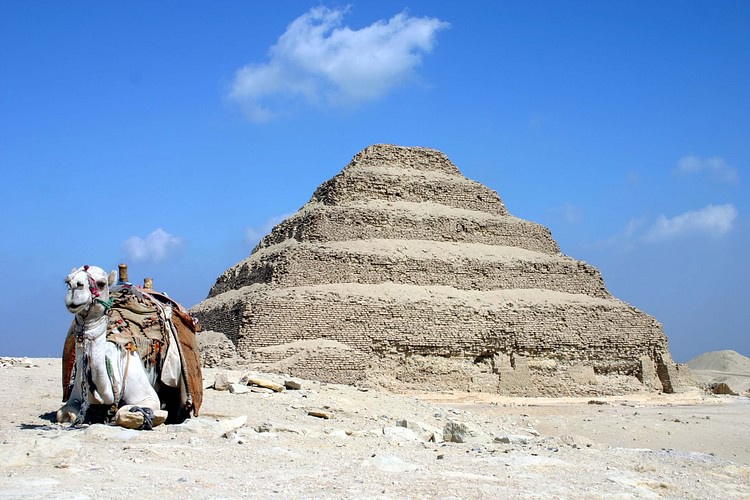
The Early Dynastic Period in Egypt (c. 3150 - c. 2613 BCE) is the beginning of the historical era of the country during which the regions of Upper Egypt (south) and Lower Egypt (north) were united as one country under a centralized government.During this period the divine rule of the kings began and a recognizable Egyptian culture, including the development of writing, arts, and sciences developed. The title ` pharaoh ' was not used during this period; rulers were referred to as `kings' and addressed as `your majesty'.
This era followed the Predynastic Period in ancient Egypt (c. 6000 - c. 3150 BCE) and was followed by the period known as the Old Kingdom (c. 2613 - 2181 BCE). While these dates are not arbitrary they should not be understood as any kind of demarcation ending one era and beginning another. They are used to help clarify the long history of Egypt by dividing its story into sections of cohesive development. The line between some periods in ancient Egyptian history does seem quite clear while, with others (such as that between the Predynastic and Early Dynastic periods) it is blurred. Dates should be understood to be approximations the further back in time one travels in Egyptian history.
EGYPT'S UNIFICATION & FIRST KING
According to the chronology of Manetho (3rd century BCE), the first king of Egypt was Menes, a king of Upper Egypt possibly from the city of Thinis (or Hierkanopolis), who overcame the other city states around him and then went on to conquer Lower Egypt. This king's name is known primarily through written records such as Manetho's chronology and the Turin King List, however, it is not corroborated by any extensive archeological evidence and scholars now believe the first king may have been a man named Narmer who peacefully united Upper and Lower Egypt at some point c. 3150 BCE. This claim is contested owing to the Narmer Palette (an ancient inscribed slab) which depicts a king, positively identified as Narmer, as a military figure conquering a region which is clearly Lower Egypt. Historian Marc Van de Mieroop comments on this:
That Egypt was created through military means is a basic concept expressed in the art of the period. A sizeable set of stone objects, including cermonial mace-heads and palettes, contain scenes of war and fighting between men, between animals, and between men and animals.Whereas in the past Egyptologists read the scenes of war literally as records of actual events, today they prefer to see them as stereotypical statements of kingship and the king's legitimacy (33).
This new method of interpreting ancient inscriptions, however valuable some may consider it, does not mean such interpretations are accurate. The argument against such interpretations asks why, if these inscriptions are to be taken symbolically, others of later periods - such as those of Rameses the Great at the Battle of Kadesh - continue to be read literally as historical record. Van de Mieroop comments further, stating, "This new approach makes it impossible to date the unification of Egypt or attribute it to a specific individual on the basis of these representations" (33-34) but notes that, whatever the case regarding the first ruler, "the art of the period shows that the Egyptians linked unification with conflict" (34). Scholar Douglas J. Brewer, on the other hand, does not see any problem in regarding the inscriptions symbolically. The name `Menes" means "He who endures" and could possibly be a title, not a personal name, in which case there is no difficulty in identifying the first king as Narmer `who endured'.
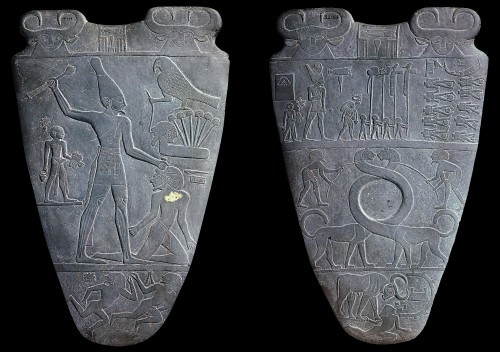
Narmer Palette
The name `Menes' has also been found on an ivory inscription from Naqada associated with Hor-Aha, which could mean the title was passed down or that Hor-Aha was the first king. Brewer notes that these ancient inscriptions, such as the Narmer Palette, perpetuate "a culturally accepted scenario and, therefore, should perhaps be regarded as a monument commemorating an achieved state of unity rather than depicting the process of unification itself" (141). To scholars such as Brewer, the means by which unification came about are not as important as the fact of unification itself. The details of the event, like those of any nation's origins, may have been largely embellished upon by later writers. Brewer writes:
Menes probably never existed, at least as the individual responsible for all the attributed feats. Rather he is most likely a compilation of real-life individuals whose deeds were recorded through oral tradition and identified as the work of a single person, thereby creating a central hero figure for Egypt's unification. Like the personalities of the Bible, Menes was part fiction, part truth, and the years have masked the borderline, creating a legend of unification (142).
Unification, Brewer (and others) claim was "most likely a slow process stimulated by economic growth" (142). Upper Egypt seems to have been more prosperous and their wealth enabled them to systematically absorb the lands of lower Egypt over time as they found they needed more resources for their population and for trade. Whether the king who united the country was Narmer or someone of another name, this king lay the foundation for the rise of one of the greatest civilizations of the ancient world.
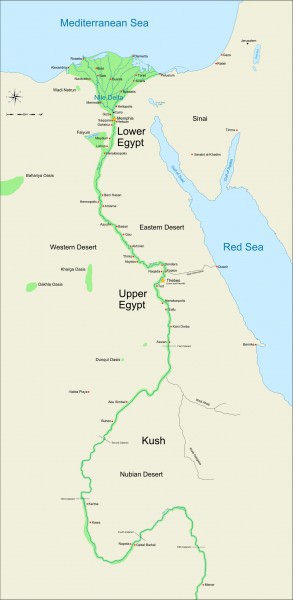
Ancient Egypt
EGYPT'S FIRST DYNASTY
The First Dynasty of Egypt (c. 3150 - c. 2890 BCE) was founded by Menes/Narmer after the unification of the country. The great Egyptologist Flinders Petrie (1853-1942 CE) accepted Narmer as the first king of the first dynasty claiming that the two names designated one man. Flinders Petrie, and others following him, claim that whether Narmer united Egypt by force is considered irrelevant in that it is almost certain he had to maintain the kingdom through military means and this would account for his depiction in inscriptions such as the Narmer Palette.
PHARAOH NARMER INITIATED LARGE BUILDING PROJECTS AND UNDER HIS RULE URBANIZATION INCREASED.
Narmer (probably from Thinis) married the princess Neithhotep of Naqada in an alliance to strengthen ties between the two cities. He led military expeditions through lower Egypt to put down rebellions and expanded his territory into Canaan and Nubia. He initiated large building projects and under his rule urbanization increased. The cities of Egypt never reached the magnitude of those in Mesopotamia perhaps owing to the Egyptians' recognition of the threats such development posed.Mesopotamian cities were largely abandoned due to overuse of the land and pollution of the water supply while Egyptian cities, such as Xois (to choose a random example), existed for millenia. Although later developments in urban development ensured the cities' continuation, the early efforts of kings like Narmer would have provided the model.
It is possible that Neithhotep ruled on her own following Narmer's death but this claim is far from universally accepted. Her tomb, discovered in the 19th century CE, was on par with a king's and suggested a status greater than simply a monarch's wife. Further evidence for her rule is her name inscribed in serakhs from the time which was a practice reserved only for a ruler, not a spouse. Still, her reign is far from clearly attested.
Narmer is instead thought to have been succeeded by his son Hor-Aha c. 3100 BCE (though some claim the two are the same person) who continued his father's military expansion and increased trade. He was especially interested in religion and the concept of the afterlife and the mastaba tomb (a house for the deceased) was developed under his reign. Hor-Aha was succeeded by his son Djer in c. 3050 BCE and continued the same policies as his predecessors. His son, Djet (c. 3000 BCE) married the princess Merneith and, upon his death, she is thought to have assumed control of the country. It is unclear whether she reigned as regent for her young son Den or ruled as queen but, either way, her reign marks the first time a woman is attested as ruling in ancient Egypt.
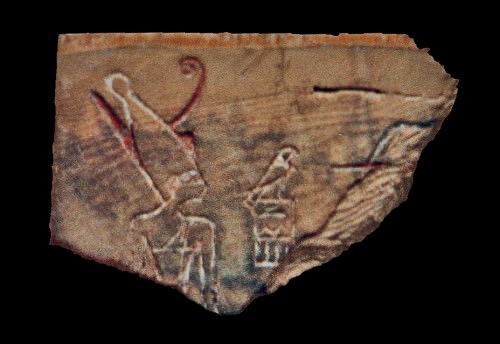
Den
Her son, Den (c. 2990 BCE) is considered the greatest king of the First Dynasty and ruled for fifty years. His reputation as an effective king comes from his improvements to the country's economy, military conquests, and the stability of his reign as evidenced by lavish building projects and intricate works of art. Den is the first ruler to be depicted wearing the crowns of Upper and Lower Egypt, clearly indicating a united nation under his rule. Den was followed by two other kings, Anedjib and then Semerkhet, who experienced difficult reigns marked by insurrection. The dynasty ended with the reign of Qa'a whose successors fought for the throne and were subdued by Hotepsekhmenwy who founded the Second Dynasty.
EGYPT'S SECOND DYNASTY
The Second Dynasty (c. 2890 - c. 2670 BCE) was marred by internal conflict and a lack of, or confusion of, records. None of the rulers of the Second Dynasty have verifiable dates and many of the names of kings seem to be repetitions of earlier rulers.Hotepsekhmenwy, whose name means "two powerful ones are at peace" is a perfect example of this problem. It would make sense, because of his name, that he came to power after subduing the princes who fought for the throne after Qa'a but his name is inscribed on the entranceway to Qa'a's tomb meaning that, 1. he was the ruler responsible for burying Qa'a and, 2. he already had that name before the war over succession broke out. The argument that the war started immediately after Qa'a's death and was crushed quickly by Hotepsekhmenwy is not supported by the archaeological evidence or the Egyptian culture which would not have allowed the king's body to lie in wait to be buried for so long. It is possible that Hotepsekhmenwy had already tried to resolve the differences between the princes prior to Qa'a's death but this is just speculation.
RANEB (NEBRA) WAS THE FIRST KING TO LINK HIS NAME TO THAT OF THE GODS AND SO ESTABLISH THE RELATIONSHIP BETWEEN THE KING AND THE DIVINE.
Even so, Hotepsekhmenwy is credited with bringing peace to Egypt upon his ascent to the throne; even though that peace was short-lived. His reign was characterized by unrest and rebellion. He was followed by Raneb (also known as Nebra) who was the first to link his name to that of the gods and so establish the relationship between the king and the divine. His successor, Nynetjer and the following, Senedji, continued to deal with the civil problems of the nation and little else is known of them.Senedji was succeeded by Peribsen (also known as Seth-Peribsen) who is a figure of some controversy among scholars.
Peribsen is the first king to separate himself from the Horus cult and embrace that of Set. This is significant because, in Egyptian religion, Horus the Younger was the son of the great god Osiris who defeated Set in order to bring harmony to the world. As harmonious balance was an important value to the ancient Egyptians, it seems strange that a king would decide to align himself with the forces associated with chaos. There is no satisfactory answer as to why Peribsen chose to do this. Early scholars believed that he was the first monotheist who declared Set the only god but this has been disproven by evidence of the worship of many gods during his reign. As his name is only recorded in Upper Egypt, there is also a theory that he chose to align with Set for political reasons; to distance himself from the Horus cult of Lower Egypt. Whatever the reason, he is considered a good king in that trade, the economy, religious practice, and the arts all flourished under his reign. The first complete sentence written in ancient Egypt was found in his tomb and reads: "The golden one, he of Ombos, hath unified and handed over the two realms to his son, the king of Lower and Upper Egypt, Peribsen" meaning that Set (he of Ombos) had blessed Peribsen's rule. The sentence also indicates that Egypt was unified under Peribsen's reign and the claim that he aligned himself with Set to distance himself from the Horus cult of Lower Egypt is untenable.
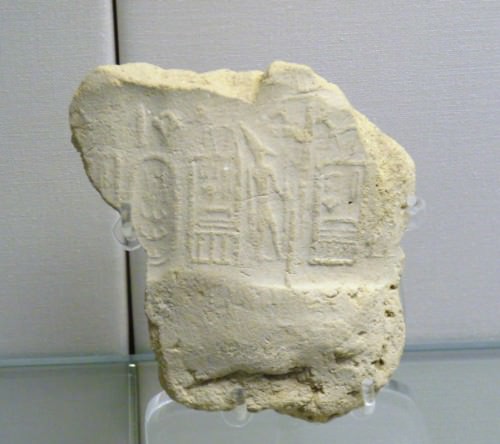
Seal of Peribsen
Peribsen was succeeded by Khasekhemwy, possibly his son, who continued the building projects of his predecessors and is thought to have brought the two regions of Egypt again under central rule or, at least, strengthened unification. His is best known for his monuments at Hierakonopolis and Abydos and as the father of the pharaoh Djoser.
EGYPT'S THIRD DYNASTY
Djoser's Step Pyramid at Saqqara is the first known pyramid built in Egypt. The Third Dynasty has been traditionally linked to the Fourth and the period known as the Old Kingdom because of its association with the first pyramids. Recent scholarship, however, has placed it at the end of the Early Dynastic Period because of the greater similarity in culture and technology with the earlier period than the latter.
The mastaba tomb was developed during the First Dynasty and the Step Pyramid at Saqqara is an elaborate, `stacked' mastaba, not a true pyramid such as those found at Giza. Djoser's pyramid, even so, is a masterpiece of technology.Designed by the vizier Imhotep, the pyramid was created as the eternal home for the king and later pyramids would follow its basic design.
DJOSER'S REIGN BROUGHT THE STABILITY NECESSARY FOR LARGE BUILDING PROJECTS AND THE DEVELOPMENT OF THE ARTS.
Djoser (c. 2670 BCE) built so many monuments that scholars have long held his reign to have lasted at least 30 years but, most likely, he ruled closer to 20. He initiated military campaigns to Sinai and maintained the cohesion of Egypt, resulting in the stability necessary for his building projects and the development of the arts. He was succeeded by Sekhemket who was followed by Khaba, both of whom also built pyramids, the Buried Pyramid and the Layer Pyramid, as well as other monuments.The Third Dynasty ends with the reign of Huni (c. 2630 - 2613 BCE) about whom little is known. Upon his death, he was succeeded by Snefru who founded the Fourth Dynasty which begins the period known as the Old Kingdom.
LEGACY
The Early Dynastic Period in Egypt was a time of revolutionary advancements in culture. The calendar was created, writing developed, knowledge of the sciences, arts, and agriculture all advanced, as did the kind of technology required to build monuments such as the Step Pyramid. Just as importantly, religious sensibility developed to a high degree; a value which would inform the rest of the history of Egypt. The concept of ma'at, harmony, became widely valued during this time and the understanding began to grow that life on earth was only one part of an eternal journey. This understanding, which was only possible for a people living under a stable government who did not have to worry about their personal safety or livelihood, led, according to the historian Bunson, "to an emerging sense of the `other' in the world, to the concept of eternity and spiritual values. Egyptians were taught that they were truly one with the divine and with the cosmos" (78). The Egyptian belief in eternity, and in the eternal life of every living thing, would become the defining characteristic of their culture and inform every monument, temple, and building they would create; especially the great pyramids which have come to be synonymous with Egypt.
LICENSE:
Article based on information obtained from these sources:with permission from the Website Ancient History Encyclopedia
Content is available under License Creative Commons: Attribution-NonCommercial-ShareAlike 3.0 Unported. CC-BY-NC-SA License